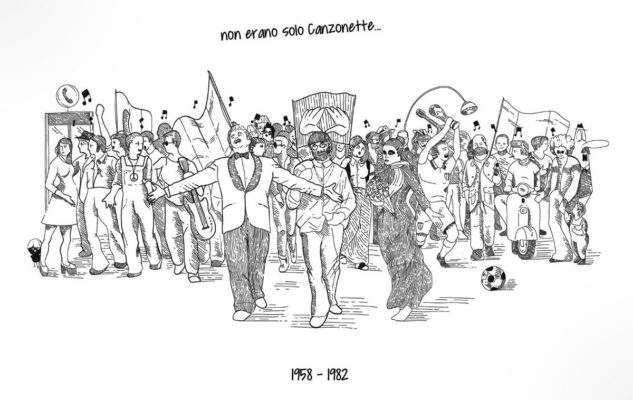An exhibition tells the story of Italy from the 1950s to the 1980s through... songs
Staged in Bologna, at the spaces of Palazzo Belloni from November 29, 2019 to April 12, 2020, the exhibition NOI ...wasn’t just songs is a great representation of recent Italian history in which “Musica d’Autore” becomes a tool for exploring and interpreting the great transformations that characterized those years.
Produced by Bibibus Events, the exhibition is curated by Gianpaolo Brusini, Giovanni De Luna, Lucio Salvini, with the participation of Fabri Fibra, Marco Tullio Giordana, Vittorio Nocenzi, Giorgio Olmoti and Omar Pedrini, to ensure its historical/scientific rigor, high cultural value and strong didactic/educational imprint.
Enclosed between Domenico Modugno ’s embrace on the stage of Sanremo 1958 and Paolo Rossi ’s embrace on the night in Madrid that graduated Italy world champions in 1982, the exhibition proceeds chronologically to touch on every aspect of social life, customs, news, work and changes in ethical and moral convictions of those years.
As a constant counterpoint, 100 Italian musical works, selected from the repertoire of that period, provide a key to its interpretation and insight. A “pas de deux” between music and society, where lifestyles, fashions, interpersonal relationships and even the same social instances are influenced by each other and vice versa.
The layout of the exhibition, curated by designer Francesca Seminatore with audio-video installations by Daniele Perrone, is divided into eleven thematic areas capable of involving both those who experienced those years firsthand and younger generations in a common journey of immersion in Italy’s collective memory. From the great immigration to the cities of the North in the late 1950s to the disengagement that shaped the 1980s, we will see the changing profile of cities and the countryside(Il Boom), the advent of consumerism(Carosello), the conquest of leisure and mass vacations(Abbronzatissimi), theemancipation of women(Pensiero Stupendo) and youth(L’Esercito del Surf), social claims and student movements(C’era un ragazzo che come me), workers’ struggles(Contessa), terrorism(La locomotiva), free radios(Musica ribelle), discos(La febbre del sabato sera) and finally the ebb that will begin the hedonistic 1980s(Splendido Splendente).
Music enjoyment in the exhibition is multi-layered: from audio spread throughout the various rooms, to works listenable through headphones, to directional speakers for period footage.
The iconographic repertoire accompanying the exhibition, comes for the most part from the invaluable Publifoto archives, whose images, destined for the daily newspapers, gravure magazines and illustrated weeklies of the time, return the gaze of the news photojournalist and his great ability to represent in an acute, profound and precise way the multiple Italian realities. Also of great importance was the contribution of the archives of QN il Resto del Carlino, which enriched the contents of the exhibition by providing exclusive photographs and historical articles from the newspaper.
Great care was given to the development of the educational project with a proposal aimed at schools and articulated on two levels: a course for teachers and a series of workshops for students in the exhibition. The four workshops (The Songs of the “Young,” Consumption, The “New” Women and Political Violence) are conducted under the guidance of expert trainers through whose guidance the children will access in a participatory way the basic knowledge useful for understanding the exhibition and for reflecting on the relationship between past and present on the continuity/breakdown axis, comparing their experience with that of previous generations.
A not-to-be-missed companion to the itinerary is the catalog published by ELI - La Spiga with photos and a historical-critical textual apparatus by the curators of the exhibition, which stands as a fascinating insight to this unique history of the imagination of Italians.
For all information you can visit the official website of the event.
Source: press release
 |
| An exhibition tells the story of Italy from the 1950s to the 1980s through... songs |
Warning: the translation into English of the original Italian article was created using automatic tools. We undertake to review all articles, but we do not guarantee the total absence of inaccuracies in the translation due to the program. You can find the original by clicking on the ITA button. If you find any mistake,please contact us.





























